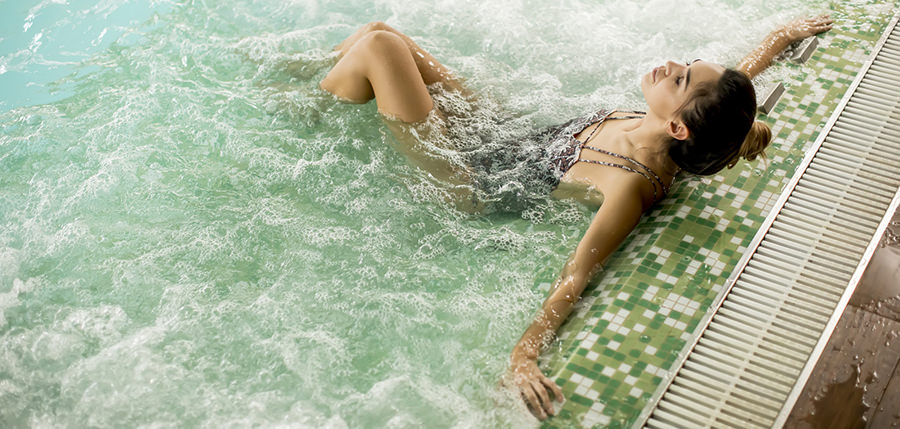
When you get the urge to jump into your hot tub for a nice long soak you want it to be up and running and ready to go. But, what happens if you have just had to refill it with water or you have just set it up again for the summer after a winter break? You will want your hot tub to heat up really fast so that you can enjoy it as soon as possible! If you follow the advice in this post you will get your hot tub to working temperature as quickly as possible. Heating your hot tub as fast as possible is relatively straight forward if you follow these handy tips.
So, how can I heat up my hot tub fast? A hot tub will generally heat water up between 3 and 6 degrees celsius per hour. You can make the process as fast as possible by using a good quality cover, making sure your hot tub is fully insulated, locating your hot tub in a sheltered spot, ensuring that the hot tub filters are clean and that the hot tub is serviced and in good working order. Adding hot water is also possible but not always a good idea.
It can be difficult to accurately predict how long it will take your hot tub to heat up. There are just so many variable factors involved not least the temperature of the water when you first put it into the hot tub along with the ambient air temperature as well.
It will also depend upon the rating of your heating element, how old your hot tub is, how well it is serviced and how well insulated it is. However, there are a number of things that you can do that will speed up the process of heating up your hot tub whatever the weather or whatever type of hot tub you have. Let’s dive in!
Fill your hot tub with warm water
First of all, the quickest and most obvious thing to do to speed up the process is to start off with water that is as warm as possible. On the face of it this sounds like a really good idea. Rather than connecting your hose to the cold tap and putting freezing cold water into your hot tub it makes sense to attach it to the hot tap and to fill your hot tub with hot water. Surely this means that the actual hot tub heating element has less work to do and say the hot tub will reach working temperature more quickly?
Unfortunately, there are a number of issues with this approach. Firstly, your hot water supply will be significantly hotter than the hot tub is designed to take and adding too much hot water too quickly could potentially damage your hot tub shell and leads to expensive repairs.
Even if this doesn’t happen your hot tub will cut out at 40 degrees so if you put water in above this temperature you’ll have a problem. Hot tubs are not designed to operate at over 40 degrees which is why this is a problem. Read my post about the correct temperature for your hot tub water here.
You could, of course, put cold water in first and then add hot water keeping it well below 40 degrees and allowing the hot tub to heat up the last few degrees to get the temperature correct. This is certainly a possibility but needs to be done with extreme care.
The other issue with adding hot water is that the hot water from your household supply might have been through a water softening filter which is problematic for hot tubs. You also might find it difficult to add an in-hose filter to filter out calcium and metals from the water without causing a water pressure problem with your hot water system.
Cold water pressure isn’t an issue but you really don’t want pressure backing up into your boiler or heating system. Bear in mind also that your heating system really probably isn’t up to the task of producing several hundred litres of hot water in a short amount of time. Do you want to constantly leave your condensing boiler switched on producing hot water or does it make sense to wait until your hot tank refills again and again?
So, filling with what hot water has its pros and cons. My general feeling is that is not actually a great idea no matter how tempting it is to speed up the process of heating up your hot tub. I wrote a whole blog post on the subject which you can read here.
Make sure your hot tub is well maintained
Yes, I know – sitting in your hot tub is relaxing and fun and hot tub maintenance is essentially rather boring! However, if you have blocked filters and a worn-out or furred up heating element it will take much much longer for your hot tub to reach working temperature.
So, make sure that you check and clean your filters on a regular basis and check them if you are draining your hot tub and refilling it. It stands to reason that if the water can’t flow freely through your filters the pump will have to work much harder which is much less energy efficient and it will also mean that the water won’t heat up evenly and will take longer to heat through.
There is a good selection of well-priced filters on this Amazon page here.

Similarly, a corroded or worn out heating element will obviously be inefficient and take significantly longer to do it’s job than a new one. Heating elements are relatively inexpensive and very straightforward to replace and should be considered as an ongoing maintenance issue for your hot tub. It makes no sense at all either in terms of speed of heating the water or energy usage to continue using a hot tub heating element that is well past its use-by date.
Again Amazon stocks a good range of new heating elements at reasonable prices and the main page is here.
Apart from the filters and the heating element make sure that any other maintenance that your hot tub supplier outlines in the handbook is carried out on a regular basis. This will simply make sure that your hot tub is working as efficiently as possible, heating as quickly as possible and even more importantly will last as long as possible.
Use a high – quality hot tub cover
As we all know hot air rises and so the hot tub cover is the first line of defence in terms of keeping the heat in your hot tub and ensuring that it heats up as quickly as possible. You really need to have a high-quality hot tub cover that fits your hot tub really well.
A thermally efficient cover will not only help the water to get hot faster but it will also help it to retain that heat. This means that your hot tub will be significantly more energy-efficient and over the lifetime of the cover, it should save you a significant amount of money in energy bills.
If your Hot Tub Cover has any holes or cracks in it or is sagging then it is probably time to replace it. The core of all hot tub covers eventually become saturated with moisture and thermally inefficient and at this point, the only real option is to purchase a new one. It’s false economy to continue using an old hot tub cover. I wrote The Ultimate Guide to Buying and Caring for a Hot Tub Cover which you can read here.
If you do have a good hot tub cover or even if you realise that your cover needs replacing, it can always help with insulation to cover the hot tub with blankets and other insulating materials while it is heating up. Remember the most heat will escape out of the top so the thicker the insulation the better.
You can also buy covers that surround the whole hot tub. These are like big tarpaulins and are really intended for winter use but there’s no reason why you can’t put this on your hot tub while it’s heating up to make absolutely sure that is a little heat is escaping as possible. It will also mean that any cold air or draughts are excluded from getting into the hot tub which can also help.
These Ultcovers on Amazon have great reviews and are extremely good quality and come in a large range of sizes.
Keep the jets off
In theory at least, if you have the jets on whilst the hot tub is heating up it encourages bubbles of cold air to circulate through the water and so slows down the heating up process. So, if you want to make the heating up process as fast as possible the best idea is to leave the jets off.
The downside to this is that the water won’t necessarily circulate particularly freely without the jets on and so you could end up with a hot tub that is warmer in some places than others. Putting the jets on towards the end, or at least periodically during the heating up process should keep the water moving and help it to heat up more evenly throughout the whole hot tub.

Position the tub carefully
The position of your hot tub can also make a big difference to how quickly it heats up and also how well it retains heat in the longer term. A hot tub in an open position in the prevailing wind will need significantly more energy to heat it up than one that is in a secluded and sunny corner. The surrounding landscape can be used to great effect to insulate the hot tub – putting up fences and barriers to prevent draughts is really effective and enclosing the hot tub in any landscaping or even in an outdoor building will make a big difference.
If you don’t like the idea of hard landscaping or moving your hot tub then how about planting a natural barrier of hedging, bamboo or other screening plants that will potentially keep your hot tub nice and snug? You will have to wait a bit of time for them to mature and thicken up but judicious planting around your hot tub can not only look extremely appealing but also help to keep the heat in as well.
Add Insulation
Unless your hot tub is completely new and state of the art the chances are that there may be opportunities for upgrading the insulation. Look around in the service bay of the hot tub for any areas that could be potentially filled as well as taking off the sides of the hot tub if possible to add further insulation in the gaps there as well. I have written a whole post on how to upgrade your insulation here.
You can use spray – on foam insulation or, alternatively, fill plastic bin bags with household insulation and stuff it into the gaps. Obviously, this has to be done with great care and you must be careful not to damage any of the pipework or fittings of the hot tub or to obstruct any of the inner workings either.
Make sure that you don’t obstruct any ventilation holes and that you don’t put insulation on any parts that get hot. Remember that if you make modifications such as adding foam to a hot tub that is still under warranty you could invalidate the warranty. If you still have a hot tub under warranty and want to investigate the possibility of upgrading the insulation then speak to your hot tub supplier.
The other place that a significant amount of heat can escape through is from the base of the hot tub. Most people don’t consider this and put their hot tub on concrete or something similar which will soak up the heat. You can buy insulation bases for hot tubs to stand on and, if you are thinking of moving your hot tub or upgrading the landscaping around it, this would be a wise investment.
Planning your hot tub activities
All of the above steps will, to a greater or lesser extent, make your hot tub heat up faster. However, even with the best will in the world it’s a process that will probably take several hours. By far the simplest plan, and the one that will take least time and effort is to set up your hot tub the day before you know that you are going to want to use it. That way you can let the water heat up at it’s own rate overnight and this also gives you time to adjust the water chemistry which is a process that can take a bit of trial and error over a period of hours.
Having a hot tub isn’t about rushing around – it’s about relaxing in a stress-free environment. For me at least, the best idea is to take your time and just plan ahead a little!
Related Questions:
How long does a hot tub or inflatable hot tub take to heat up? A hot tub will heat up water at a rate of between 3 and 6 degrees C per hour. Hot tubs are at working temperature at around 38 degrees C. To work out the amount of time it will take to heat up measure the temperature of the cold water you add to your hot tub and then work out the difference in degree between the current cold temperature and 38 degrees. At a warming rate of between 3 and 6 degrees per hour you will now be able to estimate how long your hot tub will take to heat.
Why is my hot tub not heating up? Often a hot tub that won’t heat up or is taking a long time to heat up has a water flow problem or the heating element is not working. Check that the filters are clean so that the water can flow and try putting the jets on for a short amount of time to circulate the water around. If this doesn’t work ensure that the hot tub is on the correct programme and that it isn’t showing an error message. If none of the above solve the problem then the chances are that your heating element may need replacing.
Should I leave my hot tub on all the time? To avoid the whole problem of having to heat up your hot tub regularly you could consider leaving it on all the time. This might be more energy efficient in the long term than repeatedly heating it from cold and will probably encourage you to use your hot tub more frequently. Whether it is worth it or not really depends upon your pattern of useage. If the hot tub is not used for days on end then it makes sense not to heat it constantly but if you use it two or three times a week then having it on all the time at a steady temperature will probably be more energy efficient.

